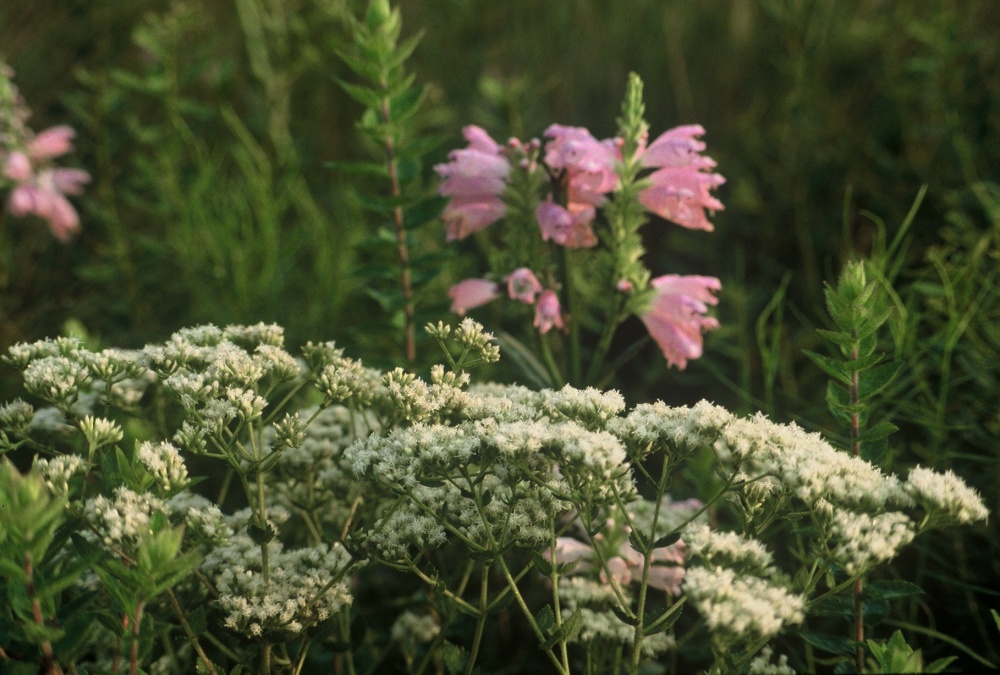
Narrow-leaf mountain mint (white) with Finger false dragonhead (pink) in prairie remnant in the 1980s.
A scent garden is in this case also a medicinal garden, as most of these plants are also medicinal herbs. These prairie plants are found in the coastal prairie. Most of these plants are native to the Cajun Prairie. Along with a scent, these plants all have a taste that is noteworthy, but I don’t usually go around the garden tasting plants nor do I recommend it—there are some that are poisonous or at minimum taste really bad—unless I have had an opportunity to make sure that they are not poisonous.
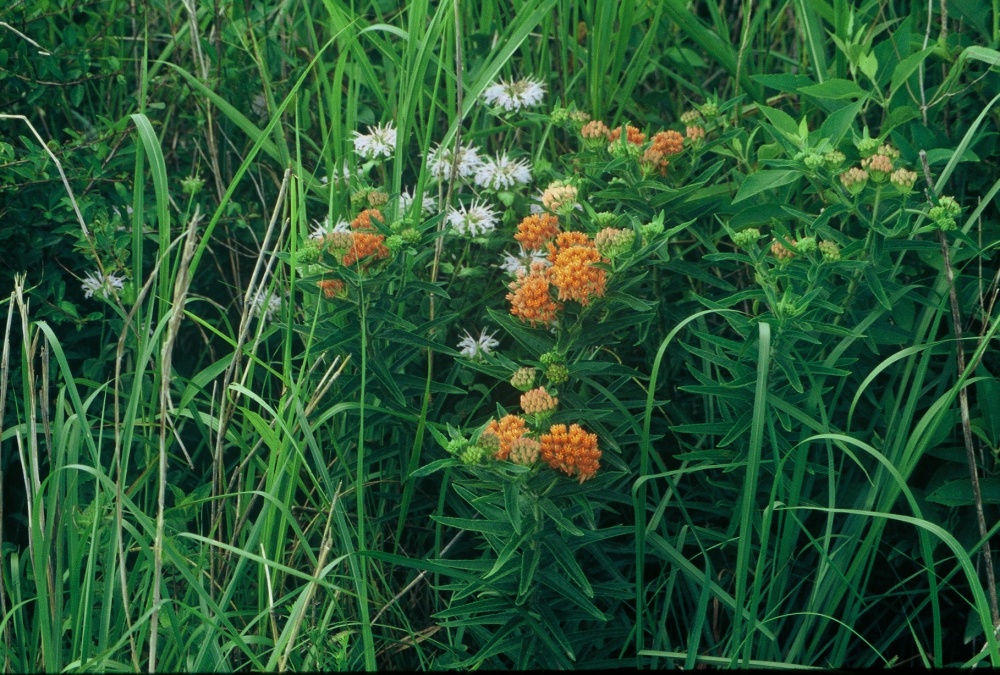
Wild bergamont (whitish pink) with Butterflyweed (orange) in remnant prairie along U. S. 190 at Swords–one of 3 locations in the Cajun Prairie where Butterflyweeds were located in the late 1980s.
Unlike a scent garden where flowers present perfumes and odors that may be especially fragrant and pleasurable, these plants have parts of the plants other than the flowers that have the scent that may or may not be pleasant depending in part on your genetics.
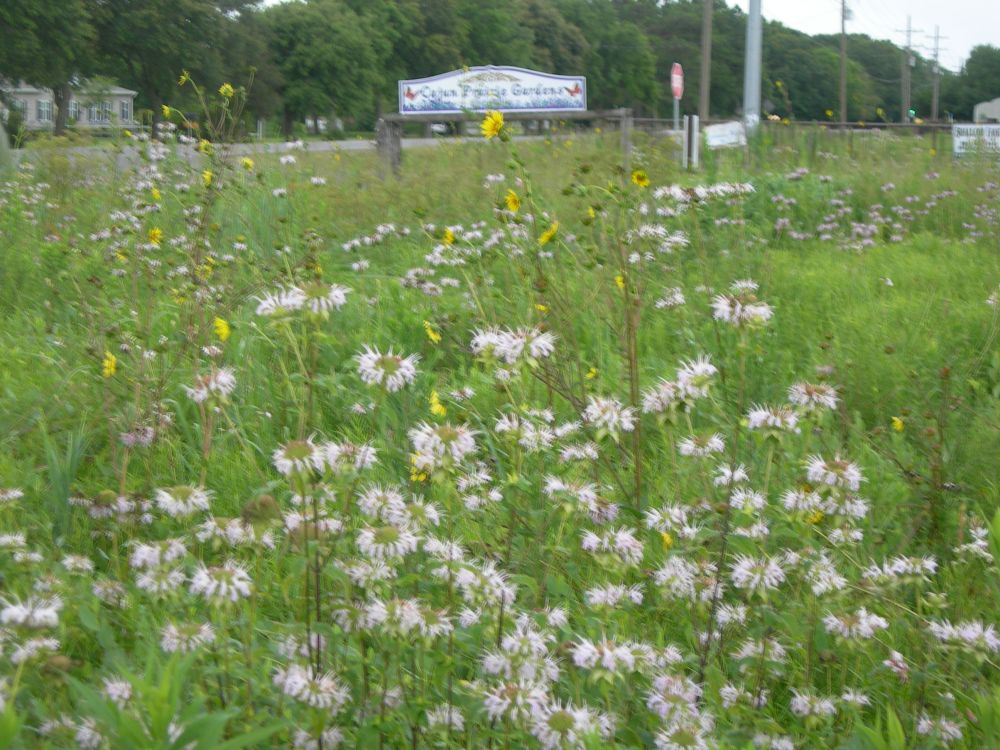
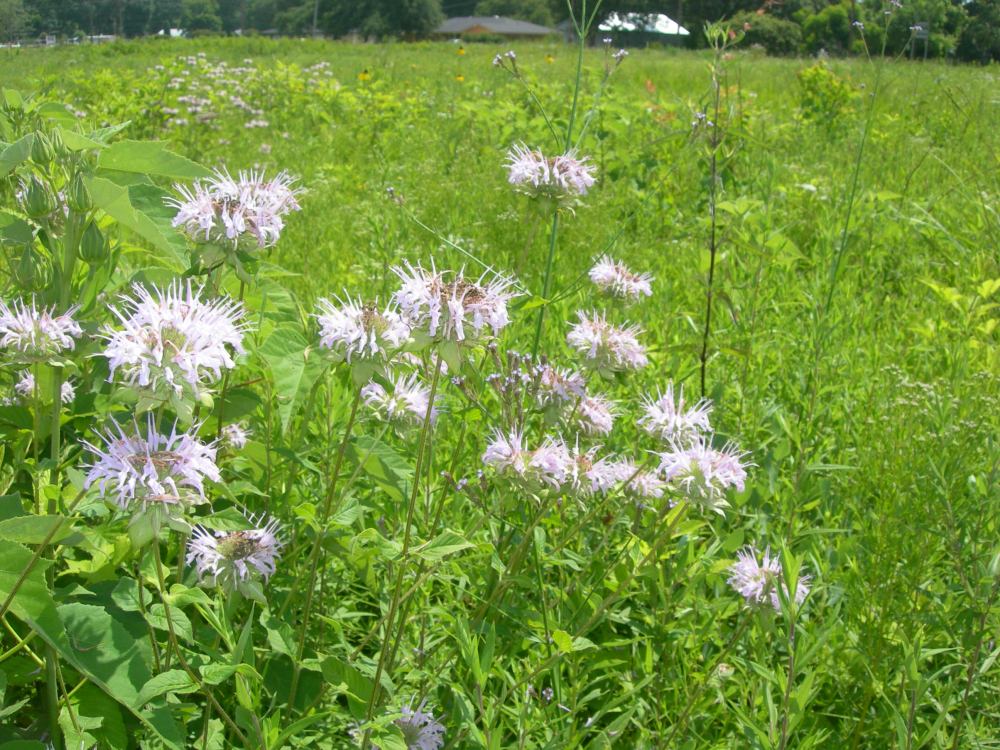
Two views of Wild bergamont in the Cajun Prairie Gardens.
Dr. Jameel Al-dujaili and his students spent a number of years doing antimicrobial studies with these scented plants. Essential oils are responsible for the scent and apparently for the antibiotic activity. After isolating the oils, the oils were tested against some very famous bacteria, including Escherichia coli (a common pathogen in meat), Staphylococcus aureus (a common pathogen on our skin that includes several varieties, which are resistant to major antibiotics), and Listeria monocytogenes (a common pathogen in salads). These analyses demonstrated varying degrees of lethality in laboratory settings, and in many cases, more than 90% effectiveness. The Mountain mints’ essential oils resulted in greater than 99% kill more often than not. Gail and I routinely chew leaves of White-leaf mountain mint when we are suffering with a sore throat or a cold.
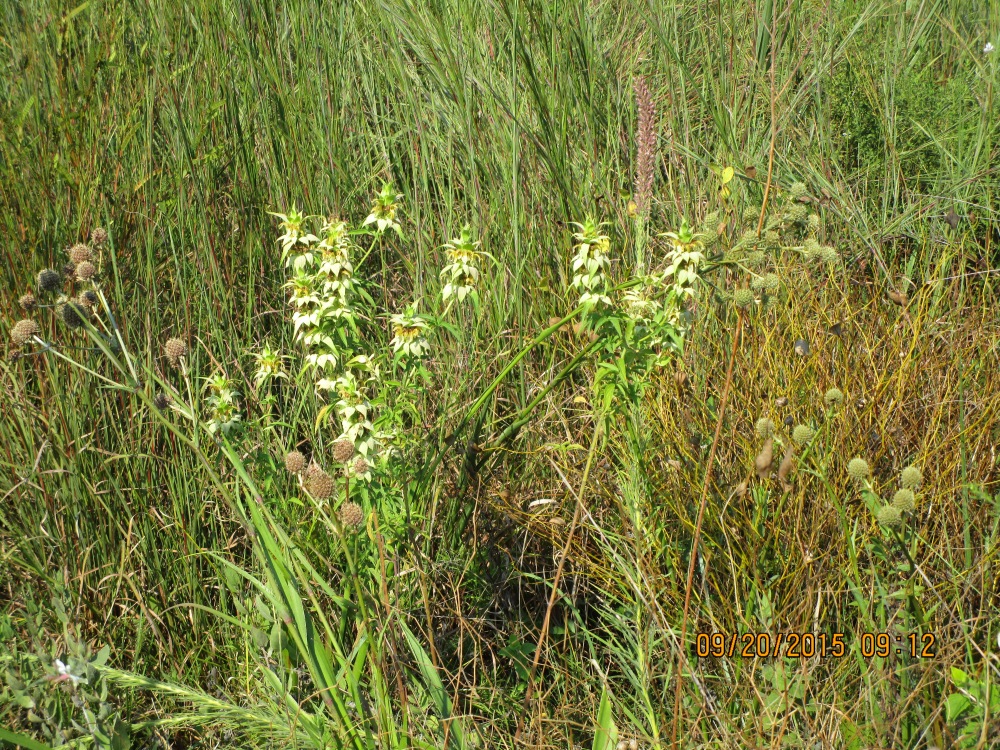
Spotted beebalm or Horsemint in the Cajun Prairie Gardens.
There are a number of Eurasian mints and scented plants (spearmint, peppermint, wintergreen, lemon mints, Society garlic and plants like basil, dill, oregano and a variety of onions and garlics) that are grown for food and scent. These could easily be companioned with our natives, but the gardener must define the garden.
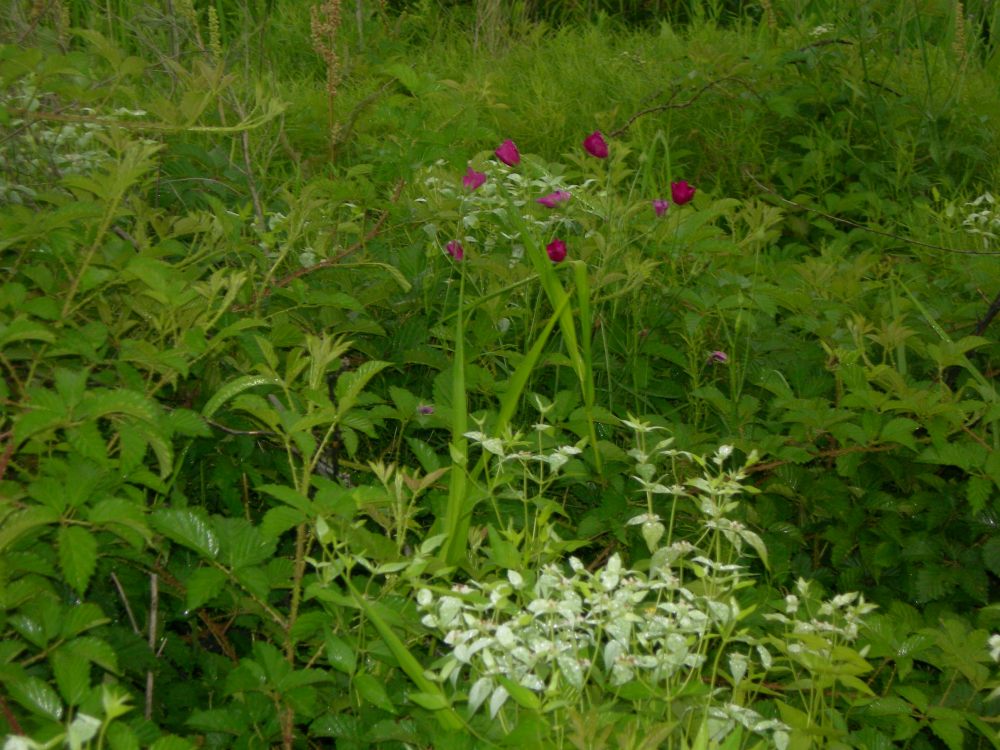
In the foreground, Clustered mountain mint blooms with Winecups in the background.

Clustered mountain mint.
Each plant has a story.
- Nothoscordum bivalve (False garlic or Crowpoison)—this little onion grows wild in yards and can number in the thousands. It blooms from November to April, with an explosion in late February through March. It is edible. Bees and butterflies are routinely seen nectaring at its flowers. The scent is that of garlic, but onion-like in some cases. It has minimal use as an antibiotic, but it did kill some bacteria in our screenings. Essential oils are responsible for the scent and apparently for the antibiotic activity.
- Allium canadense var. mobilense (Wild onion)—this little onion persists in the prairie. It sports a number of pink-white flowers in a tight cluster at the tip of the stem. It has an onion-like scent. We did not test it as an antibiotic, but it would probably work much as False garlic. This is such a beautiful and relatively rare gem in our gardens that I do not attempt to disturb them.
- Allium canadense var. canadense (Wild onion)—this is a taller onion that creates rather thick groups of plants. The scent is strong and very oniony. It is extremely easy to grow and may become weedy. It is very edible and has some antibiotic potential.
- Pycnanthemum albescens (White-leaf mountain mint)—this mint reach 4 feet in height and blooms late in the blooming season (August-November). It readily adjusts to container culture, and it produces small clusters of purplish-white flowers. It comes in a variety of scents from camphor (very medicine-like) to a spearmint /wintergreen (very pleasant). Dr. Charles Allen usually comments on how this plant reminds him of his grandmother’s sausage—she used the mint to cure the sausage. This note intrigued Dr. Al-Dujaili, and he wanted to see whether the mint was use to deter the potential sour smell of old meat or whether it was used to kill E. coli, which would grow in this stored, cured meat. The answer was both to assuage any bad smell of the meat and to kill any bacteria trying to grow in the aged meat. This mint had the most effective results in the overall tests against E. coli, but it also worked very well against the other pathogens. Marc Pastorek has honored me by routinely referring to the camphor scented variety from our prairies and gallery forests as ‘Vidrine’s camphor’ and to the spearmint/wintergreen scented variety as ‘Malcolm’s mint.’
- Pycnanthemum muticum (Clustered mountain mint)—this mint blooms in first half of the growing season. The flowers are white and cluster at the top of plants—the leaves around the flowers turn white and give the entire top of the plant a white appearance—like snow on the surface. The scent is very strong and very much like a medicine. Dr. Bruno Borsari and I did an analysis of the rate of growth (really spreading from a center plug) among prairie plants, and this species spreads at the fastest rate in the Cajun Prairie Restoration Project in Eunice. It grew within a decade to a circle some 20 feet in diameter—I suspect it might be a monster in the garden if given quality soil—somewhat reminiscent of another mint that the roots can be eaten as a raddish—Florida bethony or Florida hedgenettle (Stachys floridana). Both of these plants probably spread by rhizomes and cover a good distance underground annually. Clustered mountain mint was indeed a good antibiotic plant in our studies.
- Pycnanthemum tenuifolium (Narrow-leaf mountain mint)—this mint also blooms in the first half of the blooming season. The flowers are very small and form numerous clusters on top of the plant. It often has a distinctive minty smell, but often I find plants that have little or no smell (hint: little or no essential oils). This plant tends to spread by seed. It grows in such a manner that it might be used as a hedge that you can see through. It also has significant antibiotic activity in our studies. Many plants in my garden appear to have no scent, while others have a very pleasant minty scent.
- Monarda fistulosa (Bergamont or Wild bergamont or Beebalm)–nonspotted flowers—this mint and the next are hard to tell apart. They bloom in the first half of the blooming season and may get as much as 4 feet tall. The flowers form large showy cluster—usually blue-purple to white. A northern relative (Monarda didyma) has red flowers and is a delightful plant to grow—it is used to make something called Oswego tea with an orange-like flavor/scent. Bergamont has a significant antibiotic nature. Its scent is a bit like medicine and quite strong.
- Monarda lindheimeri (Lindheimer’s beebalm)—spotted flowers—this is a plant that is very similar to Bergamont. Lindheimer’s beebalm has a significant antibiotic nature. Its scent is a bit like medicine and quite strong. Both of these Beebalms were common in the Cajun Prairie. They form very showy clumps in May into June—a must in the scented garden. My Dad once told me that he would put some of leaves of this mint in his shirt pocket when he went to the dance so he would smell good—he might have been referring to any fragrant mint that was pleasant—the leaves are green and scented all year long.
- Monarda punctata (Horsemint or Spotted beebalm)—this mint is a late bloomer with flowers appearing in August to November. The flowers are usually yellow, but the leaves near the flowers are often tinted purple. Similar to Lemon beebalm, the flower heads can be stacked on top of one another. The scent is very strong and very much like medicine. The plant stands out in the garden, but it does not appear to persist requiring some disturbance in order to remain in the garden.
- Monarda citriodora (Lemon beebalm)—this annual mint reappears for several years, but in my garden they have long disappeared. The flowers are purplish and resemble Horsemint. The scent is usually lemon or oregano. It has been used as a roadside flower—this gives you an idea as to how tough it is. It is not a resident of the Cajun Prairie in my experience, but it is known from Coastal prairies in Texas. I had some come up in compost that I got in the mid-90s from Lafayette. It is an annual, but a great plant to grow. It persists for a couple of years, but it does not hang around.
- Solidago odora (Sweet goldenrod)—this sunflower blooms in late September to November. It is easy to recognize as its leaves tend to flex downward. The flowers can be dried and used to make a goldenrod tea—it smells and tastes much like licorice. None of the other goldenrods are known for a scent or taste, except for their relatives, the Flat-top goldenrods. The antibiotic activity was low—less than 50% in most trials.
- Euthamia spp. (Flat-top goldenrods)—this sunflower has a licorice scent when crushed. It is an early succession group of plants in the Cajun Prairie, where it can be very common. I know of no use for the plant—just the light licorice scent and the pleasant clusters of yellow flowers. Goldenrods get a lot of grief for causing allergy outbreaks at year end, but they have colored petals on their flowers and are pollinated by insects. The real culprit is the Ragweeds—flowers without petals or sepals and inconspicuous—that use the wind to move their pollen to other plants and into our sinuses.
This scent garden will also serve as a butterfly and bee garden, as these plants are pollinated by our native pollinators. This dynamic garden provides an entirely different aspect to nature—one where smells/scents can be used to identify plants not only for their uniqueness but also for their potential as medicines.
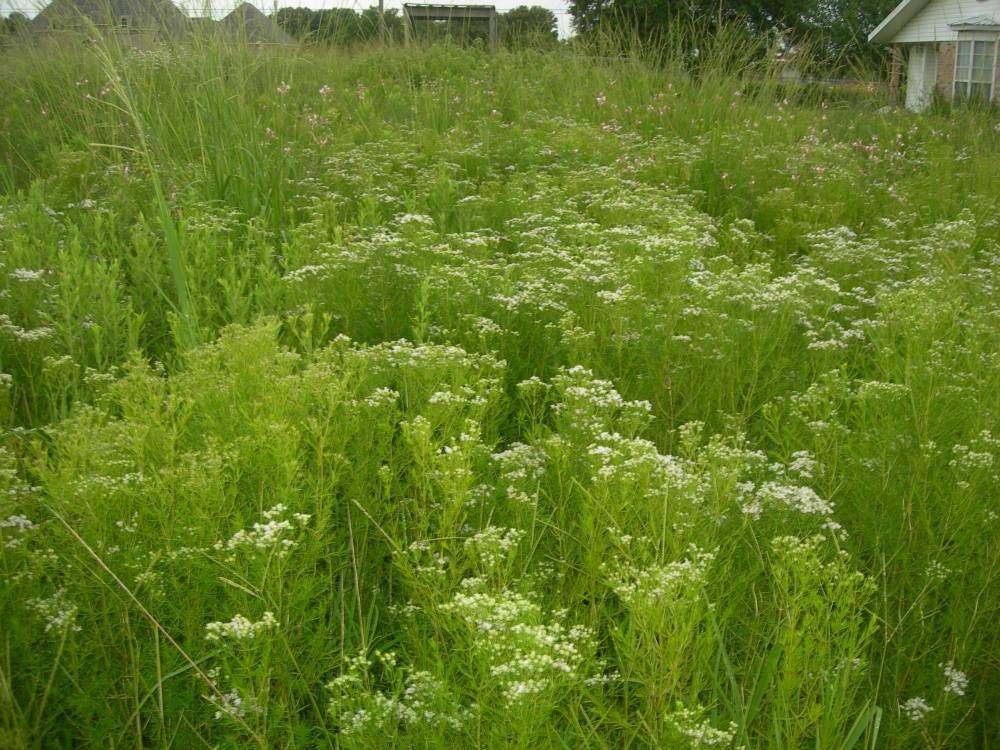
Narrow-leaf mountain mint in the milkweed meadow at the Cajun Prairie Gardens.
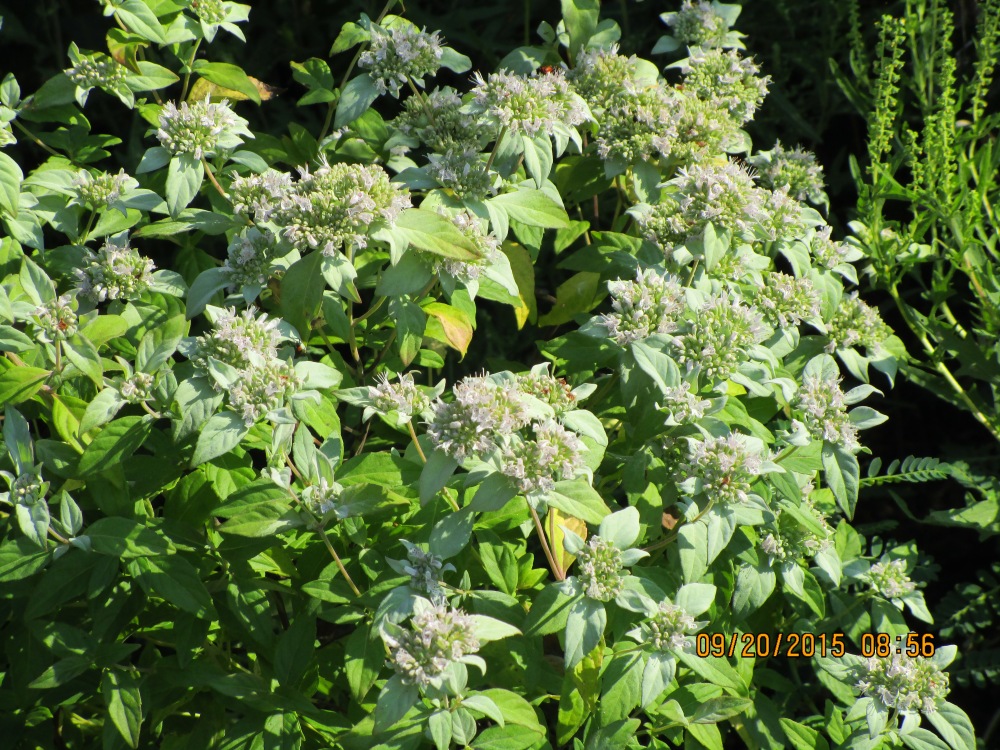
White-leaf mountain mint.
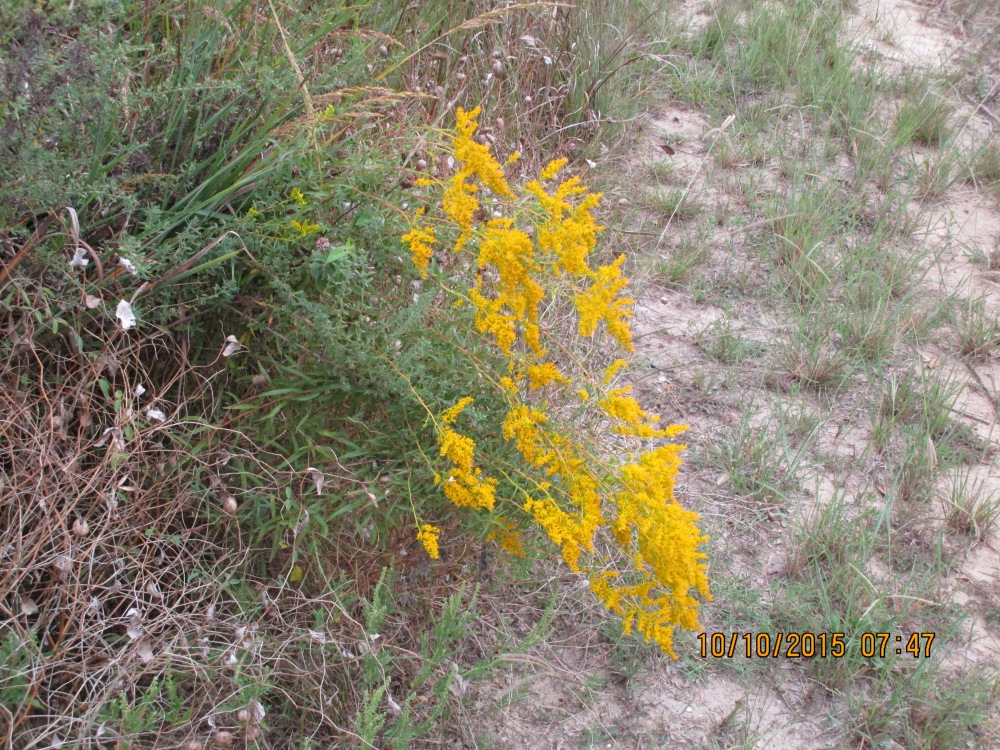
Sweet goldenrod.
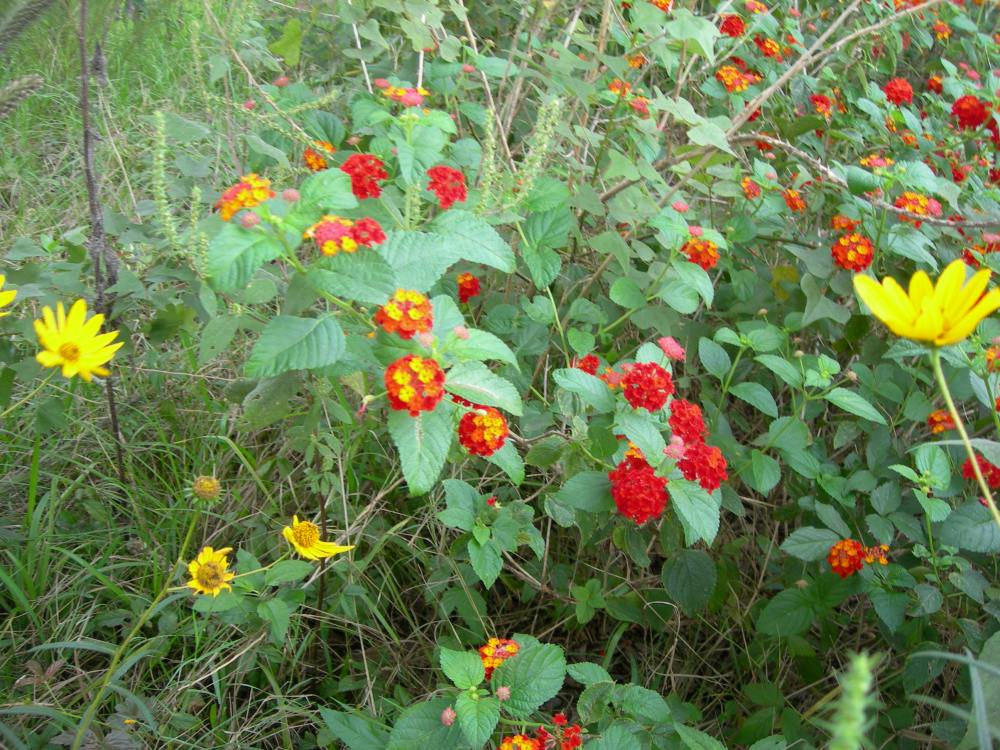
Lantana sp. (red) in the Cajun Prairie Gardens.
Other plants that may be selected for this garden include Lantana spp., Pluchea spp. and Eupatorium spp.
- Lantana spp. –many species are available in the nursery trade with a great variety of colors and growth forms. These are wonderful butterfly plants. The odor is somewhat medicinal. Whether they are native remains an unanswered question.
- Pluchea spp.—these sunflowers are sometimes called Camphorweeds. In the Cajun Prairie, 2 varieties (white and rose colored flowers) occurred. To me, the odor is somewhat pleasant, but one of the species, Pluchea foetida, is named for its horrible fetid odor. Charles Allen comments about this plant in his book, Louisiana Wildflower Guide, and notes that the plant may smell good to some and really bad to others. This reminds of tasting PTC (Phenylthiocarbamide) paper—a genetic test where some individuals have a dominant allele expressed that permits them to taste this mal-tasting chemical while others lack the allele expressed to taste the chemical at all.
- Eupatorium spp.—these sunflowers are not attractive, but they have distinctive scents. They are definitely weedy. Eupatorium capillifolium (Dogfennel) and E. compositifolium (Yankeeweed) have an interesting story that goes with them—from where I cannot recollect. According to this story, in the wake of the destruction caused by General William T. Sherman’s track to the Atlantic through Atlanta, these weeds appeared in great numbers. Thus the notion is that these weeds marked the trail of the Northern troops across Dixie as the name Yankeeweed signals. The coarse smelling scent incants some disdain among the remaining loyalists of the Confederacy.
In the garden, sometimes a plant is worth growing simply for the story that comes with it.
The prairie garden is discussed in this piece.
Why prairies matter and lawns don’t
Posted by M. F. Vidrine 030316 (malcolmvidrine@yahoo.com)